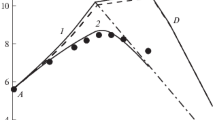Abstract
Experimental results have shown that the use of inorganic oxidizers (ammonium nitrate, ammonium perchlorate, and ammonium dinitramide) as additives does not lead to a considerable increase in the heat of explosion and acceleration ability of HMX. Ammonium perchlorate does not have an effect on the acceleration ability; however, it leads to an increase in the heat of explosion of triaminotrinitrobenzene. Calculations have shown that the acceleration ability of explosives with a low oxygen ratio can be increased through the formation of nanostructured composites with inorganic oxidizers. Calculations suggest that the addition of the studied oxidizers to CL-20 leads to a decrease in the acceleration ability of this promising explosive.
Similar content being viewed by others
References
R. R. McGuire, D. L. Ornellas, and I. B. Akst, Propellants Explos. 4, 23 (1979).
M. Finger, H. C. Horning, E. L. Lee, and J. W. Kury, in Proceedings of the 5th International Symposium on Detonation, ONR ACR-184 (Arlington, 1970), p.55.
P. J. Miller, C. D. Bedford, and J. J. Davis, in Proceedings of the 11th International Symposium on Detonation, ONR 33300-5 (Arlington, 1998), p.214.
A. Lefrancois, G. Baudin, C. le Gallic, et al., in Proceedings of the 12th International Symposium on Detonation, ONR 333-05-02 (Arlington, 2002), p.22.
M. N. Makhov, Khim. Fiz. 19 (6), 52 (2000).
V. I. Pepekin, M. N. Makhov, and Yu. A. Lebedev, Dokl. Akad. Nauk SSSR 232, 852 (1977).
M. N. Makhov and V. I. Arkhipov, Fiz. Goreniya Vzryva 25 (3), 87 (1989).
M. N. Makhov and V. I. Pepekin, Polish J. Chem. 55, 1381 (1981).
S. G. Andreev, A. V. Babkin, F. A. Baum, et al., Physics of the Explosion, Ed. by L. P. Orlenko (Fizmatlit, Moscow, 2002), Vol. 1 [in Russian].
M. N. Makhov, M. F. Gogulya, A. Yu. Dolgoborodov, et al., Fiz. Goreniya Vzryva 40 (4), 96 (2004).
M. N. Makhov, in Proceedings of the 33rd International Annual Conference of Inst. Chem. Technol. ICT (Fraunhofer Inst. Chem. Technol., Pfinztal, 2002), p. 74.
M. N. Makhov and V. I. Arkhipov, Russ. J. Phys. Chem. B 2, 602 (2008).
A. Yu. Dolgoborodov, A. N. Streletskii, M. N. Makhov, and V. E. Fortov, Russ. J. Phys. Chem. B 1, 606 (2007).
A. N. Jigatch, I. O. Leipunskii, M. L. Kuskov, N. I. Stoenko, and V. B. Storozhev, Instrum. Exp. Tech. 43, 839 (2000).
R. L. Sympson, P. A. Urtiew, D. L. Ornellas, et al., Propellants, Explos., Pyrotech. 22, 249 (1997).
Author information
Authors and Affiliations
Corresponding author
Additional information
Original Russian Text © M.N. Makhov, 2016, published in Khimicheskaya Fizika, 2016, Vol. 35, No. 2, pp. 54–60.
Rights and permissions
About this article
Cite this article
Makhov, M.N. Heat of explosion and acceleration ability of explosive–inorganic oxidizer mixtures. Russ. J. Phys. Chem. B 10, 55–61 (2016). https://doi.org/10.1134/S1990793116010188
Received:
Published:
Issue Date:
DOI: https://doi.org/10.1134/S1990793116010188



